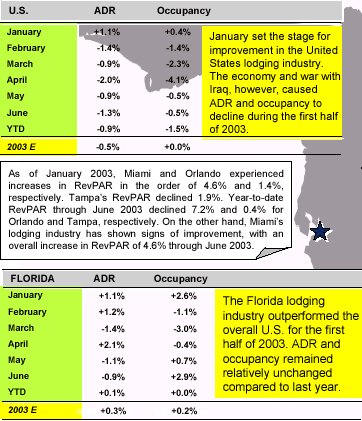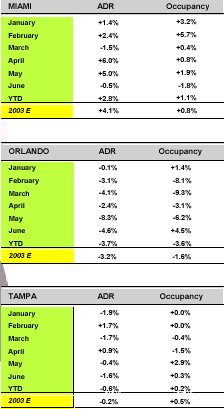U. S. Lodging
Industry Analysis
-
The U.S. lodging market posted its second annual year-over-year decline
and another disappointing year in 2002 as rooms revenue decreased approximately
0.8 percent compared to 2001 levels. The prolonged weakness in the U.S.lodging
market is primarily attributed to travel fears surrounding the war with
Iraq, international travel concerns due to SARS, and the sluggish recovery
of corporate travel. Despite the industry�s prolonged challenges, the lodging
market is poised for recovery in the long-term. Lodging demand is anticipated
to be stagnant throughout the remainder of the year with anticipated sustainable
recovery in the second half of 2004.
-
The airline industry continues to be challenged by adverse market conditions,
as evidenced by the bankruptcy of United Airlines in December of 2002.
Passenger levels on U.S. airlines declined 2.8 percent from year-to-date
2002 levels through May, according to the Air Transport Association of
America. Furthermore, during the first half of 2003, Miami, Orlando, and
Tampa experienced declines in air traffic of 3.9 percent, 1.1 percent,
and 2.7 percent, respectively. Though airline passenger levels are beginning
to exhibit signs of recovery, it is not anticipated to significantly increase
in the short-term due to continued corporate reduction in business travel
and the growing preference of domestic leisure travelers for drive-in vacation
alternatives.
-
Though many airlines are reducing flights and the growth rate for air travel
is at an all-time low, auto travel for April increased 6.7 percent over
2002 according to Travel Statistics & Trends, indicating that Americans
are choosing to stay close to home. In fact, more than half of leisure
trips this summer are anticipated to be four nights or fewer in length.
Domestic summer travel is anticipated to play a key role in the U.S. lodging
market�s performance, with average vacations anticipated to increase in
cost by 9.5 percent from 2002 to $2,378 and 80 percent of U.S. travelers
are anticipated to take a vacation this summer.
Florida Lodging
Industry Overview
-
Florida�s unemployment rate during the month of June was approximately
5.6 percent, 0.9 percentage points lower than that of the United States
and 3.4 percentage points lower than in June 2002. Miami-Dade county�s
unemployment rate in June 2003 was the highest in the state, registering
at 7.7 percent.
-
Florida recorded a banner year during 2002 in the number of visitors coming
to the state,reaching an all-time high of 75.6 million. This was mainly
attributed to an increase in drive-In demand, which represented 52 percent
of all visitors to the state. Additionally, in March 2003, Governor Bush
told the Visit Florida board that $10 to $20 million would be allocated
to tourism from the requested $40 million contingency fund to ease any
war-related slump in the state economy,compared to the $9 million the agency
normally spends annually.
-
During the first quarter of 2003, Florida received an estimated 20.1 million
visitors, a 0.2 percent increase over the same period during the prior
year despite an economic slowdown and the war with Iraq. Florida�s domestic
visitation declined 0.5 percent to 18.1 million, while overseas visitation
was up six percent to 1.2 million. Canadian visitation experienced a gain
of 8.0 percent to approximately 800,000 people.
-
The latest national survey by Travel Industry Association of America (TIA)
indicates domestic travel within the U.S. should increase approximately
2.5 percent this summer. Florida is tied with California as being number
one on these travelers� summer destination �wish list.�
-
Struggling European and Latin American economies contributed to a sharp
downturn in the state�s international visitation in 2001 and 2002. The
weakened U.S. dollar, however, is expected to make visitation to the United
States more attractive to European travelers, positively impacting tourism
in Florida in 2003.
-
The federal government recently passed legislation requiring computer-
friendly passports by October 2003 for foreign visitors from 27 countries
and biometric identifiers by October 2004. Given that Florida�s international
visitors account for approximately 10 percent of the state�s total visitation,
state officials are concerned this legislation could have a negative impact
on visitation to the state.
-
Florida�s lodging market is beginning to perform above 2002 levels. Year-to-date
occupancy as of June 2003 was 65.4 percent, at the same level as 2002.
Year-to-date average daily rate was $97.02, 0.1 percent above the same
period during 2002, resulting in an increase in RevPAR of approximately
0.2 percent. Reductions in corporate and group travel, as a result of a
persistent soft economy, have contributed to the slow improvement of the
Florida market.
-
New supply additions in Orlando (approximately 5,308 rooms over the last
two years) continue to place downward pressure on occupancy, yet should
positively contribute to average rates in the long-term due to their primarily
upscale positioning. Similarly, Miami experienced a 1.4 percent increase
in supply during the first half of 2003, mainly in the luxury segment.
These high- profile additions are anticipated to meet a definitive need
from incentive travel, convention and high- end leisure segments.
Miami Lodging
Market Analysis
-
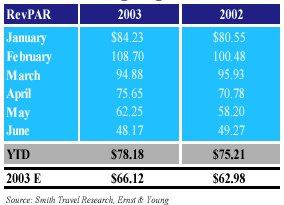 Preliminary
reports indicate that visitation was lower during the first half of 2003,
according to the Greater Miami Convention & Visitors Bureau. This is
mainly attributed to a 3.9 percent decline in air passenger arrivals through
June 2003 relative to the same period in 2002. Domestic visitation declined
4.5 percent while international visitation declined 3.2 percent over the
same period. Preliminary
reports indicate that visitation was lower during the first half of 2003,
according to the Greater Miami Convention & Visitors Bureau. This is
mainly attributed to a 3.9 percent decline in air passenger arrivals through
June 2003 relative to the same period in 2002. Domestic visitation declined
4.5 percent while international visitation declined 3.2 percent over the
same period.
-
Miami Beach Convention Center attendance for the first half of their fiscal
year (10/02 to 3/03) declined 9.7 percent compared to the same period during
the prior year. According to the Miami Beach Convention Center, an overall
decline of 1.3 percent in attendance is anticipated through September 2003.
-
Recently, Miami was ranked first for ADR growth, second for RevPAR growth,
and fourth in occupancy growth among the top 25 lodging markets during
the first half of 2003, according to Smith Travel Research. Year-to-date
occupancy, ADR, and RevPAR increased 1.1 percent, 2.8 percent, and 3.9
percent, respectively, compared to the same period during 2002; however,
operating performance is still below year-to-date June 2001 levels by 9.1
percent, 3.3 percent,and 12.0 percent in terms of occupancy, ADR, and RevPAR,
respectively.
-
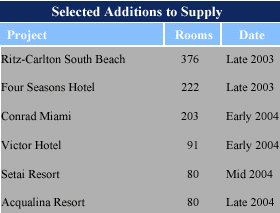 The
Miami luxury hotel market continues to forge ahead with new developments
over the next 12 to 18 months. The 376-room Ritz-Carlton South Beach, originally
scheduled to open in late 2002, will open in late 2003. The Four Seasons
Hotel & Tower will be opening in October 2003. The introduction of
the first Conrad International, Hilton�s luxury brand, to the U.S. is scheduled
for January 2004. ZOM�s redevelopment of the 91-room Victor Hotel, anticipated
to be operated by Hyatt Hotels Corporation, is expected to open on South
Beach in early 2004. The
Miami luxury hotel market continues to forge ahead with new developments
over the next 12 to 18 months. The 376-room Ritz-Carlton South Beach, originally
scheduled to open in late 2002, will open in late 2003. The Four Seasons
Hotel & Tower will be opening in October 2003. The introduction of
the first Conrad International, Hilton�s luxury brand, to the U.S. is scheduled
for January 2004. ZOM�s redevelopment of the 91-room Victor Hotel, anticipated
to be operated by Hyatt Hotels Corporation, is expected to open on South
Beach in early 2004.
-
Rosewood�s 80- unit Acqualina Resort is anticipated to open in Sunny Isles
Beach in late 2004. An 80-unit Regent condominium-hotel on South Beach
is also planned for early 2005.
-
Several new additions to supply remain in the early planning stages. One
Bal Harbour, a mixed-use development on Collins Avenue, is anticipated
to feature a 25-story residential tower with 185 units and a 17-story luxury
hotel with 124 suites. A hotel operator has not been selected yet; however,
negotiations are reportedly underway. A luxury hotel with a fractional
interest component, an upscale hotel, and a mega-yacht marina on Watson
Island is also planned.
-
Occupancy is anticipated to slightly increase in 2004 while ADR is anticipated
to moderately increase. Growth in average rate is anticipated to primarily
be the result of additional luxury supply versus real year-over-year growth
and will be subject to competitive pricing during the off-season.
Orlando Lodging
Market Analysis
-
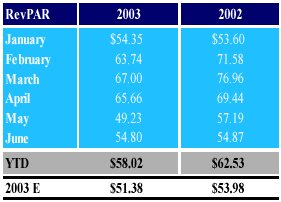 Year-to-date
figures through June 2003 indicate that airport passenger traffic decreased
1.1 percent relative to the same period during the prior year. Year-to-date
international passenger air traffic through June 2003 continues to improve,
as exhibited by an increase of 3.9 percent compared to the same period
in 2002. Nevertheless, airport representatives indicated that the south
terminal, originally slated for June 2005, has been delayed due to uncertainty
of when demand will support a new terminal coupled with the need to accommodate
new security systems. Year-to-date
figures through June 2003 indicate that airport passenger traffic decreased
1.1 percent relative to the same period during the prior year. Year-to-date
international passenger air traffic through June 2003 continues to improve,
as exhibited by an increase of 3.9 percent compared to the same period
in 2002. Nevertheless, airport representatives indicated that the south
terminal, originally slated for June 2005, has been delayed due to uncertainty
of when demand will support a new terminal coupled with the need to accommodate
new security systems.
-
Convention center events decreased 14.1 percent year- to-date through April
2003 while attendance increased 5.6 percent as compared to the same period
during the prior year, according to the Orlando/ Orange County Convention
& Visitors Bureau (�CVB�). This was driven primarily by strong performance
in January, February, and April. The one million- square foot expansion
of the Orange County Convention Center, to be completed in October 2003,
is anticipated to generate a 27 percent increase in attendance in 2004,
according to the CVB.
-
According to market representatives, Disney�s park attendance declines
have adversely impacted lodging performance in the area. During 2002, attendance
remained 12.8 percent below 2000 levels.
-
During the first half of 2003, occupancy, ADR and RevPAR declined 3.6 percent,
3.7 percent, and 7.2 percent, respectively, as compared to the same period
during 2002. Orlando�s operating performance is still below 2001 levels
by 9.5 percent, 6.2 percent, and 15.2 percent in terms of occupancy, ADR
and RevPAR, respectively.
-
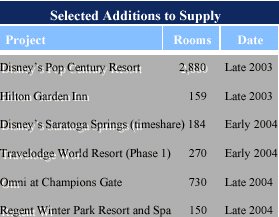 In
terms of new supply, the 1,000 room J.W. Marriott and 584-room Ritz-Carlton
at Grand Lakes recently opened in July 2003. The proposed 1,500- room Hyatt,
the 1,200- room Hilton, and the 1,000-room expansion of The Peabody currently
remain on hold. Other hotel projects are still underway, including the
2, 880- room Disney Pop Century Hotel (Phase I) and the 730-room Omni at
Champions Gate. The 1,500- room Rosen Hotel is anticipated to open in January
2006. The resort, located adjacent to the convention center expansion and
Beeline Expressway, will feature approximately 250,000 square feet of meeting
space, an 18-hole golf course, and full-service spa. In
terms of new supply, the 1,000 room J.W. Marriott and 584-room Ritz-Carlton
at Grand Lakes recently opened in July 2003. The proposed 1,500- room Hyatt,
the 1,200- room Hilton, and the 1,000-room expansion of The Peabody currently
remain on hold. Other hotel projects are still underway, including the
2, 880- room Disney Pop Century Hotel (Phase I) and the 730-room Omni at
Champions Gate. The 1,500- room Rosen Hotel is anticipated to open in January
2006. The resort, located adjacent to the convention center expansion and
Beeline Expressway, will feature approximately 250,000 square feet of meeting
space, an 18-hole golf course, and full-service spa.
-
In order to maintain their competitive posture, both the Marriott Orlando
World Center and the Swan/Dolphin are undergoing significant renovations
of both guestrooms and public areas and adding meeting space.
-
Occupancy is anticipated to slightly increase in 2004, while ADR should
remain unchanged relative to 2003.
Tampa Lodging
Market Analysis
-
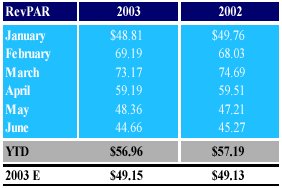 Year-to-date
figures through June 2003 indicate that airport passenger traffic declined
2.7 percent relative to the same period last year. Domestic visitation
declined 2.8 percent while international visitation declined 0.5 percent
over the same period. Year-to-date
figures through June 2003 indicate that airport passenger traffic declined
2.7 percent relative to the same period last year. Domestic visitation
declined 2.8 percent while international visitation declined 0.5 percent
over the same period.
-
The Tampa Bay Convention & Visitors Bureau is initiating an innovative
marketing campaign that offers meeting planners an opportunity to write
and submit their own version of an ideal contract for later discussion
to boost meeting group demand. The campaign opens the door for the meeting
planner to submit a proposal with a �zero� rooms attrition clause, or a
Food & Beverage attrition �waived� clause that is not guaranteed, but
subject to a �serious� discussion. The Tampa Bay Convention & Visitor
Bureau also commissioned an extensive study that justified doubling the
current space of 279,000 square feet at the Tampa Bay Convention Center.
In 2003, the convention center is anticipated to slightly exceed the 175,000
room nights its events generated in 2002. The convention center expects
to generate 200,000 room nights in 2004 and 210,000 in 2005.
-
Year-to-date occupancy in the Tampa area improved slightly relative to
2002 levels. Occupancy through June 2003 reached 66.1 percent, only 0.2
percent above 2002 levels during the same period. ADR and RevPAR declined
0.6 percent and 0.4 percent, respectively. Furthermore, Tampa remains below
2001 operating performance levels by 6.5 percent, 8.2 percent, and 14.2
percent in terms of occupancy, ADR and RevPAR, respectively.
-
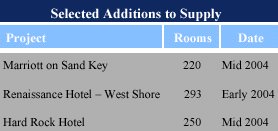 In
terms of new supply, the West Shore lodging market will receive its first
new upscale hotel property in mid 2004. A 293-room Renaissance Hotel is
currently under development by CNL Financial Group, Inc. The hotel is also
CNL�s first property in the Tampa Bay area and will be located at the International
Plaza shopping center, within one mile of Tampa International Airport.
Additionally, Marriott International is converting the Radisson Suites
on Sand Key into the first full-service Marriott in Pinellas County in
January 2004. In
terms of new supply, the West Shore lodging market will receive its first
new upscale hotel property in mid 2004. A 293-room Renaissance Hotel is
currently under development by CNL Financial Group, Inc. The hotel is also
CNL�s first property in the Tampa Bay area and will be located at the International
Plaza shopping center, within one mile of Tampa International Airport.
Additionally, Marriott International is converting the Radisson Suites
on Sand Key into the first full-service Marriott in Pinellas County in
January 2004.
-
Construction for the Hard Rock Hotel & Casino Resort is also underway.
The hotel, scheduled to open in March 2004 and located in the Seminole
Indian Nation reservation, represents an economic generator that will add
1,500 jobs. The proposed resort will feature 250 rooms, ten restaurants,
and 10,000 square feet of meeting space. The first phase of the 90,000-
square foot casino operation opened in June 2003.
-
Additionally, negotiations are underway between an Indiana hotel developer
and city officials to build a 400-unit Embassy Suites hotel across Franklin
Street from the Tampa Convention Center.
-
Both occupancy and ADR are anticipated to slightly increase in 2004.
|
